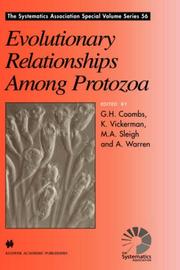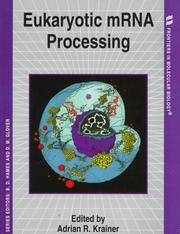| Listing 1 - 10 of 138 | << page >> |
Sort by
|

ISBN: 041279800X Year: 1998 Publisher: Dordrecht : Kluwer,
Abstract | Keywords | Export | Availability | Bookmark
 Loading...
Loading...Choose an application
- Reference Manager
- EndNote
- RefWorks (Direct export to RefWorks)
PROTOZOA --- PROTOZOA --- EUKARYOTES --- CONFERENCES --- EVOLUTION --- SYSTEMATICS --- PHYLOGENY --- PROTOZOA --- PROTOZOA --- EUKARYOTES --- CONFERENCES --- EVOLUTION --- SYSTEMATICS --- PHYLOGENY
Book
ISBN: 0124371736 Year: 1995 Publisher: London Academic Press
Abstract | Keywords | Export | Availability | Bookmark
 Loading...
Loading...Choose an application
- Reference Manager
- EndNote
- RefWorks (Direct export to RefWorks)
Molecular biology --- EUKARYOTES --- GENETIC REGULATION --- TRANSCRIPTION FACTORS --- TRANSCRIPTION
Multi
ISSN: 23302968 Year: 1961 Publisher: Odense : International Phycological Society,
Abstract | Keywords | Export | Availability | Bookmark
 Loading...
Loading...Choose an application
- Reference Manager
- EndNote
- RefWorks (Direct export to RefWorks)
A journal for information about any aspect of phycology
Algae --- Natuurkunde. --- Algas --- Limu --- Cryptogams --- Phytoplankton --- Algology --- Eukaryota. --- Eucarya --- Eukarya --- Eukaryotes --- Eukaryotas --- Eukaryote
Periodical
ISSN: 16890027 Year: 1963 Publisher: Warsaw : Nencki Institute of Experimental Biology
Abstract | Keywords | Export | Availability | Bookmark
 Loading...
Loading...Choose an application
- Reference Manager
- EndNote
- RefWorks (Direct export to RefWorks)
Protozoa --- Protozoa. --- Protozoans --- Protozoons --- Invertebrates --- Protista --- Protozoology --- Eukaryota. --- Eucarya --- Eukarya --- Eukaryotes --- Eukaryotas --- Eukaryote
Book
Abstract | Keywords | Export | Availability | Bookmark
 Loading...
Loading...Choose an application
- Reference Manager
- EndNote
- RefWorks (Direct export to RefWorks)
The deep subsurface is, in addition to space, one of the last unknown frontiers to human kind. A significant part of life on Earth resides in the deep subsurface, hiding great potential of microbial life of which we know only little. The conditions in the deep terrestrial subsurface are thought to resemble those of early Earth, which makes this environment an analog for studying early life in addition to possible extraterrestrial life in ultra-extreme conditions. Early microorganisms played a great role in shaping the conditions on the young Earth. Even today deep subsurface microorganisms interact with their geological environment transforming the conditions in the groundwater and on rock surfaces. Essential elements for life are richly present but in difficultly accessible form. The elements driving the microbial deep life is still not completely identified. Most of the microorganisms detected by novel molecular techniques still lack cultured representatives. Nevertheless, using modern sequencing techniques and bioinformatics the functional roles of these microorganisms are being revealed. We are starting to see the differences and similarities between the life in the deep subsurface and surface domains. We may even begin to see the function of evolution by comparing deep life to life closer to the surface of Earth. Deep life consists of organisms from all known domains of life. This Research Topic reveals some of the rich diversity and functional properties of the great biomass residing in the deep dark subsurface.
Nitrogen Cycle --- Methane --- Eukaryotes --- Iron oxidation --- cave --- Groundwater --- Terrestrial deep biosphere --- MINE --- Heavy metal resistance --- microbiome
Book
Abstract | Keywords | Export | Availability | Bookmark
 Loading...
Loading...Choose an application
- Reference Manager
- EndNote
- RefWorks (Direct export to RefWorks)
The deep subsurface is, in addition to space, one of the last unknown frontiers to human kind. A significant part of life on Earth resides in the deep subsurface, hiding great potential of microbial life of which we know only little. The conditions in the deep terrestrial subsurface are thought to resemble those of early Earth, which makes this environment an analog for studying early life in addition to possible extraterrestrial life in ultra-extreme conditions. Early microorganisms played a great role in shaping the conditions on the young Earth. Even today deep subsurface microorganisms interact with their geological environment transforming the conditions in the groundwater and on rock surfaces. Essential elements for life are richly present but in difficultly accessible form. The elements driving the microbial deep life is still not completely identified. Most of the microorganisms detected by novel molecular techniques still lack cultured representatives. Nevertheless, using modern sequencing techniques and bioinformatics the functional roles of these microorganisms are being revealed. We are starting to see the differences and similarities between the life in the deep subsurface and surface domains. We may even begin to see the function of evolution by comparing deep life to life closer to the surface of Earth. Deep life consists of organisms from all known domains of life. This Research Topic reveals some of the rich diversity and functional properties of the great biomass residing in the deep dark subsurface.
Nitrogen Cycle --- Methane --- Eukaryotes --- Iron oxidation --- cave --- Groundwater --- Terrestrial deep biosphere --- MINE --- Heavy metal resistance --- microbiome
Book
Abstract | Keywords | Export | Availability | Bookmark
 Loading...
Loading...Choose an application
- Reference Manager
- EndNote
- RefWorks (Direct export to RefWorks)
The deep subsurface is, in addition to space, one of the last unknown frontiers to human kind. A significant part of life on Earth resides in the deep subsurface, hiding great potential of microbial life of which we know only little. The conditions in the deep terrestrial subsurface are thought to resemble those of early Earth, which makes this environment an analog for studying early life in addition to possible extraterrestrial life in ultra-extreme conditions. Early microorganisms played a great role in shaping the conditions on the young Earth. Even today deep subsurface microorganisms interact with their geological environment transforming the conditions in the groundwater and on rock surfaces. Essential elements for life are richly present but in difficultly accessible form. The elements driving the microbial deep life is still not completely identified. Most of the microorganisms detected by novel molecular techniques still lack cultured representatives. Nevertheless, using modern sequencing techniques and bioinformatics the functional roles of these microorganisms are being revealed. We are starting to see the differences and similarities between the life in the deep subsurface and surface domains. We may even begin to see the function of evolution by comparing deep life to life closer to the surface of Earth. Deep life consists of organisms from all known domains of life. This Research Topic reveals some of the rich diversity and functional properties of the great biomass residing in the deep dark subsurface.
Nitrogen Cycle --- Methane --- Eukaryotes --- Iron oxidation --- cave --- Groundwater --- Terrestrial deep biosphere --- MINE --- Heavy metal resistance --- microbiome --- Nitrogen Cycle --- Methane --- Eukaryotes --- Iron oxidation --- cave --- Groundwater --- Terrestrial deep biosphere --- MINE --- Heavy metal resistance --- microbiome
Book
ISBN: 0935868135 Year: 1985 Publisher: Lawrence (Kansas) : Society of protozoologists,
Abstract | Keywords | Export | Availability | Bookmark
 Loading...
Loading...Choose an application
- Reference Manager
- EndNote
- RefWorks (Direct export to RefWorks)
Eukaryota. --- Eucarya --- Eukarya --- Eukaryotes --- Eukaryotas --- Eukaryote --- GBZ General Biology, Zoology & Biophilosophy --- general biology --- zoology --- Protozoa --- guide books --- Eukaryota

ISBN: 0199634173 0199634181 Year: 1997 Publisher: Oxford : IRL Press,
Abstract | Keywords | Export | Availability | Bookmark
 Loading...
Loading...Choose an application
- Reference Manager
- EndNote
- RefWorks (Direct export to RefWorks)
Genetic transcription. --- Messenger RNA. --- Basic Sciences. Molecular Biology --- Nucleic Acids --- Nucleic Acids. --- GENE EXPRESSION --- MESSENGER RNA --- CONTROL --- EUKARYOTES --- MATURATION
Book
ISBN: 3540062394 0387062394 3642619606 3642619584 9783540062394 Year: 1973 Publisher: Berlin Springer
Abstract | Keywords | Export | Availability | Bookmark
 Loading...
Loading...Choose an application
- Reference Manager
- EndNote
- RefWorks (Direct export to RefWorks)
When I prepared the first German edition of this book in 1955, it was my intention to acquaint biologists in my country with the new and exciting results being obtained on the other side of theAtlantic Ocean (incl. the English Channel). In the meantime, especially after publication of the second German edition in 1968, Dr. Konrad F. Springer and many colleagues, too, suggested that I should prepare an English version. Though this was the exact opposite of my original intention, I finally agreed despite the risks involved. Since 1968 our knowledge in Protozoology increased considerably. Though I tried to concentrate the text as much as possible, an enlargement of up to pages 554 was unavoidable. Many figures have been changed, replaced and added. Altogether their number increased from 422 to 437. In my opinion, it is only a matter of time before the "true" protozoologists dis appear. There will be cell biologists, biochemists, geneticists and others working with certain Protozoa, but very few who are interested in the group as a whole, their morphological and physiological diversity, their various types of reproduction and their relationships to other groups of organisms. Even at the present time, the Society of Protozoologists, comprising more than thousand members, consists for the most part of specialists who concentrate their efforts specifically upon Chlamy domonas, Amoeba, Plasmodium, Tetrahymena or some other protozoans.
Protozoans --- Protozoology --- Eukaryota. --- Protozoan Infections. --- Infections, Protozoan --- Histomoniasis --- Histomoniases --- Infection, Protozoan --- Protozoan Infection --- Eucarya --- Eukarya --- Eukaryotes --- Eukaryotas --- Eukaryote --- Protozoology. --- Protozoa --- Protozoa. --- Microbiology. --- Bacteriology. --- Zoology. --- Eukaryota --- Protozoan Infections
| Listing 1 - 10 of 138 | << page >> |
Sort by
|

 Search
Search Feedback
Feedback About UniCat
About UniCat  Help
Help News
News